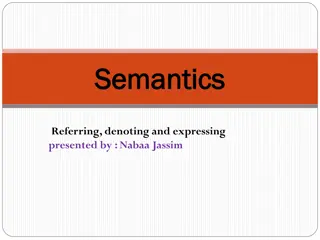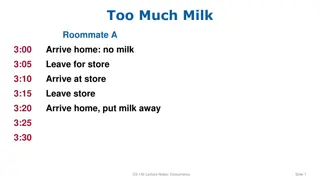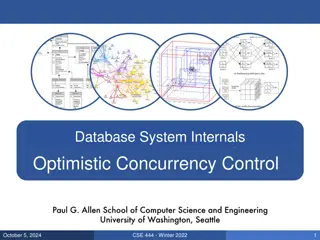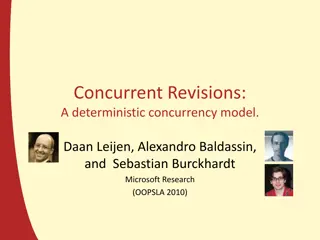Understanding Semantics and Locking Specifications in Concurrency
Exploring the importance of semantics and locking specifications in concurrent programming, this content delves into issues such as data races, unsafe code, and solutions like locking discipline to manage shared data effectively and prevent corruption.
Download Presentation

Please find below an Image/Link to download the presentation.
The content on the website is provided AS IS for your information and personal use only. It may not be sold, licensed, or shared on other websites without obtaining consent from the author. Download presentation by click this link. If you encounter any issues during the download, it is possible that the publisher has removed the file from their server.
E N D
Presentation Transcript
Semantics for Semantics for locking specifications locking specifications Michael D. Ernst Michael D. Ernst, , Damiano Massimo Massimo Merro Damiano Macedonio Macedonio, , Merro, Fausto , Fausto Spoto Spoto University of Washington, USA Universit di Verona, Italy NFM 2016
Concurrency: essential but error Concurrency: essential but error- -prone prone +Essential for performance (exploit multiple cores) +Design component of GUIs -Data races: concurrent access to shared data easy mistake to make leads to corrupted data structures difficult to reproduce and diagnose
Thread Thread- -unsafe code unsafe code class BankAccount { int balance; void withdraw(int amount) { int oldBal = this.balance; int newBal = oldBal - amount; this.balance = newBal; } ...
Data race Data race example example Shared account Initial balance = 500 Thread 1: sharedAccount.withdraw(50) Thread 2: sharedAccount.withdraw(100) 500 int oldBal = this.balance; int newBal = oldBal - amount; this.balance = newBal; int oldBal = this.balance; int newBal = oldBal - amount; this.balance = newBal; 500 500 100 500 50 400 450 Withdrawals = 150 Final balance = 450
Solution: locking Solution: locking class BankAccount { Locking: Only one thread can aquire the lock No concurrent access to data Which lock to hold? Object acctLock; int balance; int balance; @GuardedBy( acctLock ) int balance; void withdraw(int amount) { int oldBal = this.balance; int newBal = oldBal - amount; this.balance = newBal; } synchronized (acctLock) { Key issues: Names vs. values Aliasing }
Locking discipline = Locking discipline = which locks to hold when accessing what data which locks to hold when accessing what data @GuardedBy("lock1") int w; @GuardedBy("lock2") int x; @GuardedBy("lock2") int y; int z; Write locking discipline as documentation and for use by tools @GuardedBy [Goetz 2006] is a de-facto standard On GitHub, 35,000 uses in 7,000 files Its semantics is informal, ambiguous, and incorrect (allows data races) Similar problems with other definitions
Contributions Contributions Formal semantics for locking disciplines unambiguous prevents data races two variants: value-based, name-based Two implementations: type-checker that validates use of locking inference tool that infers locking discipline Experiments: programmer-written @GuardedBy: are often inconsistent with informal semantics permit data races even when consistent
Each object is associated with a monitor or intrinsic lock. Concurrency background Concurrency background specification of locking discipline Date d = new Date(); synchronized statement or method locks the monitor. @GuardedBy("d") List lst = ...; guard expression; arbitrary, e.g. a.b().f arbitrary, e.g. a.b().f guard expression; synchronized (d) { lst.add(...) lst.remove(...) otherList = lst; } Exiting the statement or method unlocks the monitor. Our implementations handle explicit locks too.
Guard expression: Aliases? Reassignment? Scoping? Side effects? Scoping? Guard expression: Aliases? Reassignment? Value protection answers Yes No Yes Def site Defining a locking discipline Defining a locking discipline Informally: If program element x is annotated by @GuardedBy(L), a thread may only use x while holding the lock L. Element being guarded: Name or value? Aliases? Reassignments? Side effects? Side effects? Element being guarded: Name or value? Aliases? Reassignments? Value Yes Yes Yes MyObject lock; @GuardedBy("lock.field") Pair shared; @GuardedBy("lock.field") Pair alias; What is a use? Any occurrence of name? Dereferences of name? Dereferences of value? Dereference of value? What is a use? Occurrence of name? Dereference of name? (x.f) synchronized (lock.field) { shared.a = 22; alias = shared; } current better
MyObject lock; @GuardedBy("lock") Pair shared; Pair alias; Name protection Name protection not value protection not value protection Value protection Value protection not name protection not name protection synchronized (lock) { alias = shared; } alias.a = ... shared = alias; synchronized (lock) { shared.a = ... } Suffers a data race No data race
L Locking ocking discipline discipline semantics providing providing value value protection type qualifier semantics protection @GuardedBy("lock") Pair shared; variable type Suppose expression x has type: @GuardedBy(L) C A use is a dereference Type system constraint; may lock an alias When the program dereferences a value that has ever been bound to x, the program holds the lock on the value of expression L. The referent of L must not change while the thread holds the lock. cv No reassignment of guard expression. Side effects permitted (do not affect the monitor).
L Locking ocking discipline discipline semantics providing providing name name protection semantics protection @GuardedBy("lock") Pair shared; variable variable annotation type Suppose variable v is declared as @GuardedBy(L) A use is a variable read or write No aliasing permitted When the program accesses v, which must not be aliased, the program holds the lock on the value of expression L. Lmay only be itself or this . Guarantees L always evaluates to the same value
Key Key contributions contributions Two formal semantics (name-based and value-based) Core calculus based on RaceFreeJava [Abadi TOPLAS 2006] Structural Operational Semantics Definitions of accessed variables and dereferenced locations Proofs of correctness By contradiction: assume data race show locking discipline must have been violated
Static analysis of a locking discipline Static analysis of a locking discipline Goal is to determine facts about values Program is written in terms of facts about variables Analysis computes an approximation (an abstraction) of values each expression may evaluate to of locks currently held by the program Both abstractions are sound
Enforcement of value semantics Enforcement of value semantics via type via type- -checking checking [Ernst ICSE 2016] Type rule: If x : @GB(L) , then L must be held when x is dereferenced Type system also supports method pre/postconditions (@Holding annotations) side effect annotations type qualifier polymorphism reflection flow-sensitive type inference No two @GuardedBy annotations are related by subtyping Why not @GB(L1) <: @GB(L1, L2)? Side effects and aliasing
Inference of both semantics Inference of both semantics via abstract interpretation via abstract interpretation [Spoto TOPLAS 2003] Expression e is @GuardedBy(L) if e s fields are accessed only when L is held [Nikolic ICTAC 2012] Acquired on entry to sync( ){ }. Released on exit or side effect.
Inference implementation Inference implementation 1. Where is the guarded element used? Name protection: syntactic uses of variable Value protection: estimate via creation points analysis 2. What expressions are locked at those points? Definite aliasing analysis Side effect analysis Viewpoint adaptation (contextualization) Whole-program analysis Makes closed-world assumption Type-checking is modular, incremental
Experimental evaluation of value semantics Experimental evaluation of value semantics [Ernst ICSE 2016] 15 programs, 1.3 MLOC BitcoinJ, Daikon, Derby, Eclipse, Guava, Jetty, Velicity, Zookeeper, Tomcat, 5 contain programmer-written @GuardedBy annotations 661 correct annotations Candidates: annotations written by the programmer or inferred by our tool Correct: program never suffers a data race on the element Determined by manual analysis Results: Inference: precision 100%, recall 83% Type-checking: precision 100%, recall 99% Programmers: precision 50%, recall 42%
Programmer mistakes Programmer mistakes Errors in every program that programmers annotated with respect to both value and name semantics Creating external aliases Lock writes but not reads Syntax errors Omitted annotations
Implementations Implementations Type checker: Lock Checker, distributed with the Checker Framework http://CheckerFramework.org/ Live demo: http://eisop.uwaterloo.ca/live Inference: Julia abstract interpretation http://juliasoft.com/
Related work Related work Name-based semantics: JML, JCIP, rccjava [Abadi TOPLAS 2006], Heuristic checking tools: Warlock, ESC/Modula-3, ESC/Java Unsound inference: [Naik PLDI 2006] uses may-alias, [Rose CSJP 2004] is dynamic Sound inference for part of Java [Flanagan SAS 2004] Type-and-effect type systems: heavier-weight, detects deadlocks too Ownership types
Contributions Contributions Formal semantics for locking disciplines unambiguous prevents data races two variants: value-based, name-based Two implementations: type-checker that validates use of locking discipline (@GuardedBy) inference tool that infers locking discipline (@GuardedBy) Experiments: programmer-written @GuardedBy: are often inconsistent with informal semantics permit data races even when consistent with informal semantics























